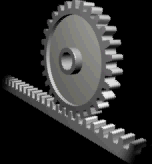
A rack and pinion is a type of linear actuator that comprises a circular gear (the pinion) engaging a linear gear (the rack).[1] Together, they convert between rotational motion and linear motion: rotating the pinion causes the rack to be driven in a line. Conversely, moving the rack linearly will cause the pinion to rotate.
The rack and pinion mechanism is used in rack railways, where the pinion mounted on a locomotive or a railroad car engages a rack usually placed between the rails, and helps to move the train up a steep gradient. It is also used in arbor presses and drill presses, where the pinion is connected to a lever and displaces a vertical rack (the ram). In pipelines and other industrial piping systems, a rack displaced by a linar actuator turns a pinion to open or close a valve. Stairlifts, lock gates, electric gates, and the mechanical steering mechanism of cars are other notable applications.
The term "rack and pinion" may be used also when the rack is not straight but arcuate (bent), namely just a section of a large gear.[2]
A single pinion can simultaneously drive two racks, parallel but opposite; which will always be displaced by the same distance, only in opposite directions. Conversely, by applying opposite forces to the two racks one can obtain pure torque on the pinion, without any force component. This double rack and pinion mechanism can be used, for example, with a pair of pneumatic actuators to operate a valve with minimum stress.[3]
- ^ Gear Nomenclature, Definition of Terms with Symbols. American Gear Manufacturers Association. 2005. p. 72. ISBN 1-55589-846-7. OCLC 65562739. ANSI/AGMA 1012-G05.
- ^ Phillips, Jack (2003). General Spatial Involute Gearing. Berlin, Heidelberg: Springer Berlin Heidelberg. ISBN 3662053020.
- ^ "Automax SuperNova Series Pneumatic Rack & Pinion Actuators" (PDF). Flowserve Corporation. Retrieved 7 July 2014.